

The Index of Medieval Art is pleased to continue a series of blog posts that delve into the history of the organization through interviews with senior scholars in the field of art history. The “Guest Book Series” takes its name from the Index guest books, which have been signed by scores of art historians who have consulted the Index files over the past century. We’ve enjoyed reading their recollections, and warmly thank Alison Stones, Professor Emerita, University of Pittsburgh, and Index friend for her time and responses.
Please tell us a little about yourself and your work. Where did you study? What inspired you to become a medievalist?
In the Fall of 1969, I emerged as a not-quite Ph.D. from the Courtauld Institute (that happened a year later in December 1970/January 1971) to begin what would turn out to be a life-long academic career in the United States. My academic background was in French and German literature, followed by a medieval art and architecture specialty at the Courtauld where I worked with the inimitable Christopher Hohler, and with David Ross at Birkbeck, with musicology from Ian Bent at King’s and Heraldry with Nick Norman at the Wallace Collection.
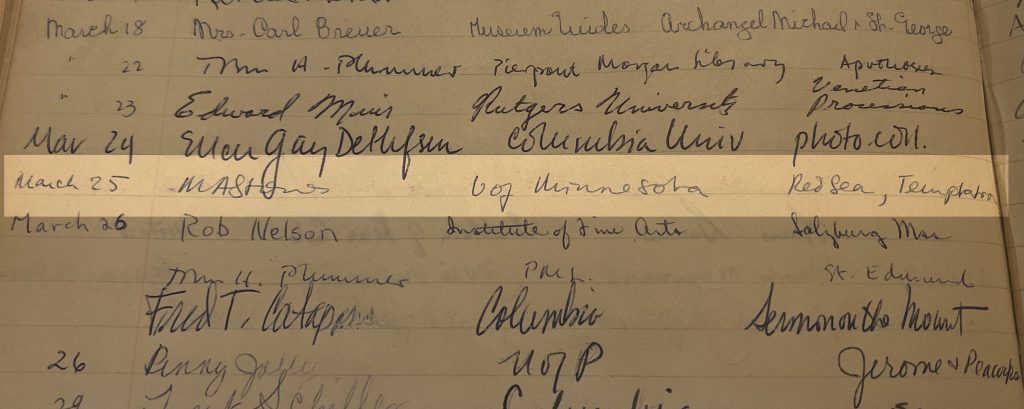
When was your first visit to the Index in Princeton? Where was the Index located? With whom did you work there? Do you remember anything especially interesting about your visit?
By 1969 I already had many friends in the US, notably Adelaide Bennett at the Index, Paula Gerson then at Fordham, James Marrow at Binghamton, and Bob Deshman at Toronto, Canada. All of them had worked alongside me in London, so the transition to the US was easy for me and all of them made me feel welcome there. The Index, under Rosalie Green, was among my first stopping places and continued over the years to be a haven for my research on French illuminated manuscripts, from the days of the invaluable old card system up to the new innovations of the 21st century. Adelaide and I would argue back and forth over the limitations and benefits of “Index-Speak” which invited us to hone our descriptive (and analytical) skills, and more recently it was a pleasure to encounter my former student Judith Golden among the ranks of the Index staff. One simply learned so much there!
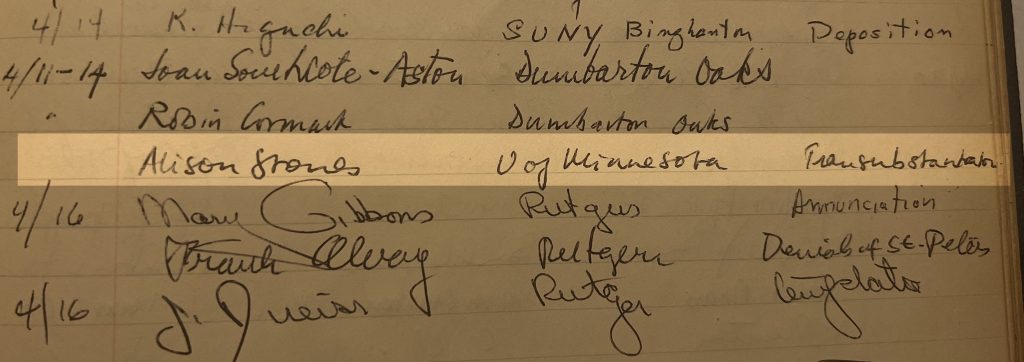
Under Colum Hourihane came the era of the Index conferences, not-to-be missed sessions of innovative research, captured with regularity in the impressive series of publications produced under his editorship. I was privileged to attend many of these conferences and to participate in Iconography at the Index: Celebrating Eighty Years of the Index of Christian Art (1997),[1] Between the Picture and the Word: The Book of Kings (Morgan 638) in Focus (2004),[2] as well as the festschrift volume Tributes to Adelaide Bennett Hagens: Manuscripts, Iconography, and the Late Medieval Viewer (2017).[3] Naturally, these essays all depended heavily on research conducted at the Index, where I must admit that my preference was still the old card system rather than the new, online version. Thankfully, the Index conferences are ongoing, and now available online with a livestream link. From the presentations to the interaction that follows, one learns so much!
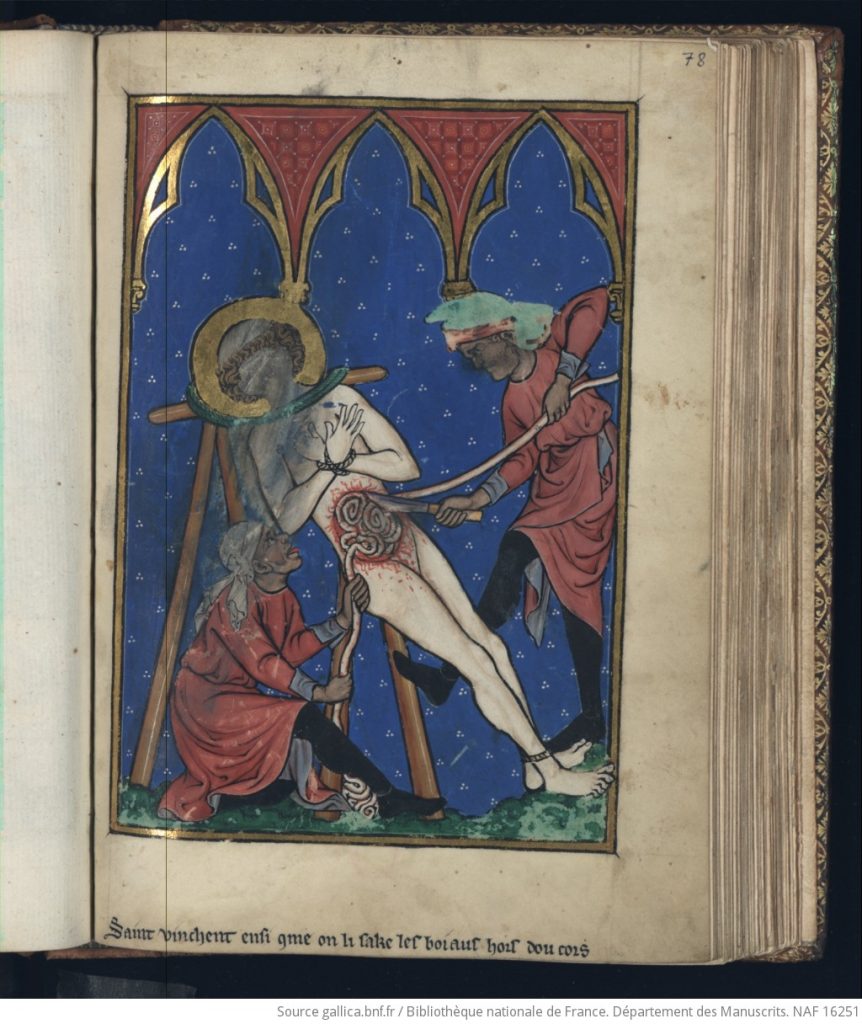
Do you have any observations about the evolution of the Index files and database over the last three decades? Where do you think Index work should go next?
As to future directions for the Index, I wish it could become a repository for the many online medieval databases (my own included) that risk becoming defunct once their creator retires. I appreciate the logistical issues and the problems of different software, but so much creative work is out there, and risks being lost. This in addition to the very valuable repository of information and images that make the Index such an indispensable tool for all medievalists. Long may it continue to flourish and many thanks for all I have learned there!
[1] Alison Stones, “Nipples, Entrails, Severed Heads and Skin; Devotional Images for Madame Marie,” in Image and Belief: Studies in Celebration of the Eightieth Anniversary of the Index of Christian Art, ed. Colum Hourihane (Princeton: Department of Art & Archaeology and Princeton University Press, 1999), 48–64.
[2] Alison Stones, “Questions of Style and Provenance in the Morgan Picture Bible,” in Between the Picture and the Word: The Book of Kings (Morgan 638) in Focus: A Colloquium in Honor of John Plummer, ed. Colum Hourihane (Princeton: Department of Art & Archaeology and Princeton University Press, 2004), 112–121.
[3] Alison Stones, “Tobit: A Recently Rediscovered Cutting from the Brussels-Rylands Bible,” in Tributes to Adelaide Bennett Hagens: Manuscripts, Iconography, and the Late Medieval Viewer, eds. Pamela A. Patton and Judith K. Golden (London: Harvey Miller Publishers, 2017), 335–353.
This blog post is the seventh in a series focusing on members of the Index staff. Today we introduce Jon Niola.
What is your role at the Index?
I am the Information Technology Manager here at the Index. I manage the day-to-day technology needs of the Index. That includes everything from managing virtual machines on the cloud to deploying new computers for staff or writing code to enhance the accessibility of our web applications.
Before working for the Index, what was the most interesting job you had?
In the late 1990s I worked at a technology startup in New York City trying to improve Internet search. We used algorithms to make a search more appropriate to the context. For example, if you searched for the keyword “jaguar,” were you searching for the automobile or the animal? Our algorithms used recent searches and site visits to try and narrow the scope.
When you’re not working at the Index, what do you like to do in your spare time?
If the weather cooperates, I absolutely love to hike, and I spend quite a bit of time on the trail, getting some exercise and fresh air and enjoying the tranquility.
Do you have a favorite work of art or favorite place you’ve visited?
Sainte-Chapelle in Paris. I had always planned on visiting it when I went to Paris, but to me it was just a bucket list, “must do” item. I never expected it to be so incredible in person. I had a few thousand dollars of camera gear with me, and no photo I took does justice to the beauty of it, especially the upper chapel with the incredible stained glass.
What’s your favorite building or spot to sit on campus?
This is a tough call. I can’t choose between Nassau Hall and the university chapel.
The chapel is beautiful, and at certain times of the day when the angle of the sun is right, you get these beautiful colors on the stone as the sun filters through the stained glass.
The history buff in me appreciates Nassau Hall. The fact that it once served as the capitol of the United States is fascinating to me. We are blessed with a lot of great local history.
Coffee or tea?
Yes. I often drink coffee in the morning, but I do love a good tea.
This blog post is the sixth in a series focusing on members of the Index staff. Today we introduce Fiona Barrett.
What is your role at the Index?
My role at the Index is that of Office Administrator/Coordinator. The exciting part of my job, which is not at all traditional (in the administrative sense), is that I am able to assist where/when needed in the Index database and library. If you’ve seen the #IndexHumpDay posts on social media, you’ll see my weekly interaction with iconography—a variety of camels depicted across media, geographies, and time periods.
Before working for the Index, what was the most interesting job you had?
Before working for the Index, I worked in market research for twenty-five years, which—while interesting and challenging at times—in no way compares to my experience here at the Index. I’m very grateful to be exposed to all of this art history, and lucky enough to have colleagues who take the time to explain things to me when needed.
When you’re not working at the Index, what do you like to do in your spare time?
Hmm … a few of my favorite things: cooking, eating, entertaining, reading, gardening, traveling, listening to music (especially my husband’s 😊), and I love spending time with family and friends; they are one and the same.
Do you have a favorite work of art or favorite place you’ve visited?
I spent part of my childhood growing up in Ireland, but I truly didn’t appreciate the country and the history until I was in my early thirties. I was lucky enough to travel back a few times, with my father and then with my son. I would go again in a heartbeat! This year I am planning to travel to Italy, which has been on my bucket list for quite some time.
What do you like best about being back on campus in person?
Now that we’re back in person, and I am working with colleagues face-to-face, it’s great to be able to have our in-person conferences and workshops once again. This past conference—“Looking at Language” in November 2022—brought together over fifty attendees, and seven of the eight speakers were able to present in person.
Coffee or tea?
YES, PLEASE!
The Index staff is pleased to announce the relaunch of the Index’s digital image collections, which have recently undergone a massive upgrade. The updated platform hosts ten collections of images generously donated to the Index and made freely accessible to the public through the Index website. These unique documentary resources include more than 50,000 images of medieval art and architecture and reflect the varied interests and travels of their twentieth-century photographers. They represent a range of subjects, techniques, and media, including English medieval embroidery, medieval and Byzantine manuscripts, European choir stall sculpture and stained glass, and Gothic and Romanesque architecture.

Although the images in these collections have not been cataloged with the same level of detail as those in the iconographic database, every effort has been made to assign them basic information regarding location, date, and in many cases, iconographic subjects. The latter can be found in browse lists that include a variety of iconographic topics, including saints and martyrs, animals, zodiac, occupations, and secular and religious scenes, all updated to follow the current subject standards of the main Index database. Browsing these subject lists reveals much about each collection. For instance, the subject list for the “Opus Anglicanum” database—an image collection of medieval English needlework on ecclesiastical and secular textiles—includes numerous saints especially venerated in England, with multiple scenes for Margaret of Antioch, Nicholas of Myra, and Thomas Becket.
Browsing the subject list of another collection, the Elaine C. Block database of misericords, reveals the wide variety of drôleries that decorated the wooden under-seat structures: fantastic creatures, battling animals, and figures playing in sports and games, engaged in occupations, or enacting proverbial lessons. John Plummer’s database of medieval manuscripts includes large numbers of biblical and apocalyptic images, including scenes with Christ, David, and the Virgin Mary, and other popular saints found in late medieval prayer books. The subjects in Plummer’s collection closely resemble those found in Jane Hayward’s collection, perhaps reflecting the shared interests of two scholars were curators at major collections in New York City during the second half of the twentieth century.

The Gabriel Millet collection comprises the study and teaching images of that scholar, an important archaeologist and historian of the early twentieth century who specialized in Byzantine art. Subjects represented here include multiple biblical figures and scenes, but also Byzantine generals and emperors and several text subjects, such as the Chronicle of Manasses and the biblical psalms by number.
The Gertrude and Robert Metcalf Collection of Stained Glass is a documentary treasure for the study of Gothic stained glass. The Metcalfs, who were both stained glass artists and experienced photographers, took more than 11,000 images of stained glass from European monuments, covering sites in Austria, England, France, Germany, and Switzerland. Their images of stained glass windows are a fascinating record of a fragile artistic medium, captured during fragile times. Their travels coincided with the dawn of World War II in Europe over the years 1937 and 1939, and they produced a body of documentary evidence that became critical to postwar restoration efforts. A look at the Metcalf subject list reveals many of the expected themes in medieval iconography, but also significant iconographic cycles for several French bishops, such as Austremonius and Bonitus of Clermont, Germanus of Auxerre, and Martialis of Limoges.
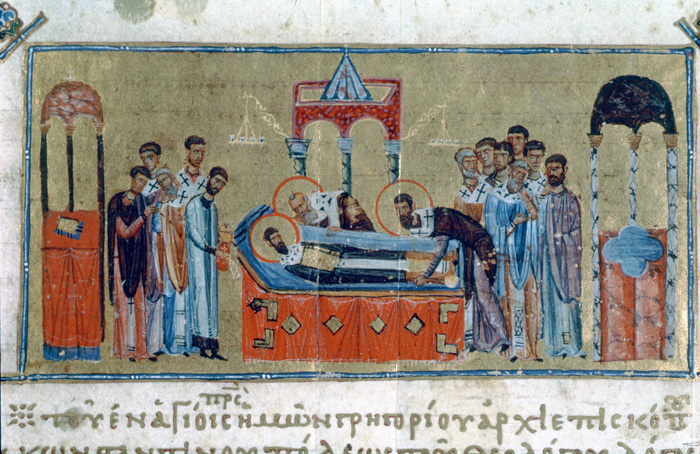
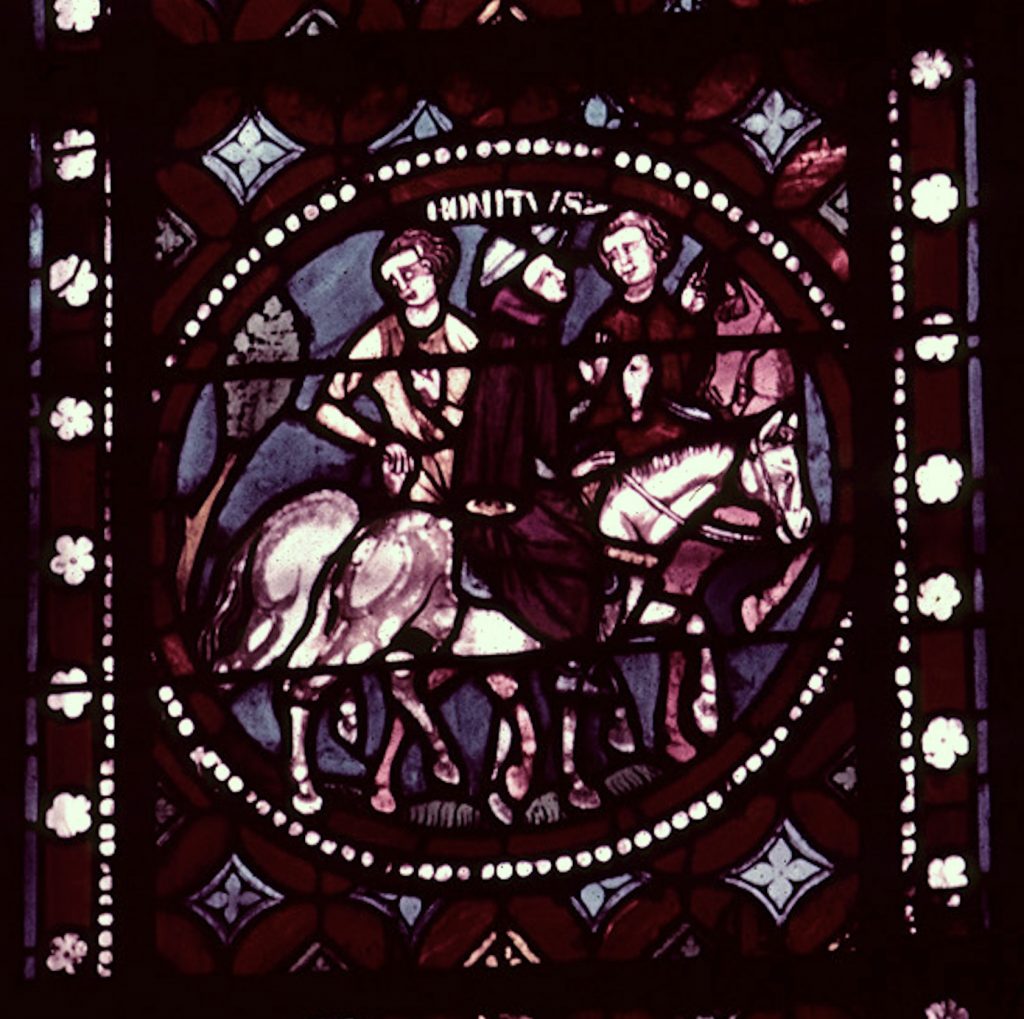
Geographically, the collections cover country and city locations in four continents—Europe, Africa, Asia, and North America—from obscure sites to famous ones, and they include many types of repositories, from in-situ locations to museums, libraries, and private collections. To better accommodate browsing by region, locations in all the collections have been formatted to begin with the country. Each collection is introduced with general information about its history, scope, and image use policies. It has been satisfying to edit and release these collections—now with more consistent information and a more secure digital platform—knowing that they are now more useful to scholars. Your feedback on the collections is welcome via this form.
Continuing a series of blog posts introducing the new features of our online database.
The Index of Medieval Art database catalogs more than 26,000 subjects. For a long time, you could explore this vast taxonomy only by browsing the subject headings in alphabetical order. To make the data more accessible, the Index has developed a Subject Classification browse tool, which allows researchers to discover Index holdings by browsing through various categories of our hierarchical classification of subjects.
In this network, subjects are grouped under five top-level headings:
By browsing the contents of these categories, researchers can learn more about Index subjects as grouped by theme. Researchers interested in the “History” category, for example, will encounter individual subjects, such as the names of historical figures and their associated scenes within a medieval society, grouped under classifications such as “Heraldry,” “Donors,” “Founders,” and “Nobility.” Other groups in this category include “Those Who Pray” (including representations of religious clergy, pilgrims, missionaries, hermits and heretics), “Those Who Fight” (with admirals, generals, officers, etc.), “Those Who Rule” (with emperors, empresses, doges, despots, prefects, etc.), and “Those Who Work” (including medieval occupations by type, such as philosophers, physicians, and scholars).
The category “Religious Subjects” contains diverse subject matter, mainly figures and scenes, but also objects and rituals, not only for the three Abrahamic faiths of Christianity, Judaism, and Islam, but also for several other ancient religions, such as Greek, Roman, and Egyptian mythology. The unsurprisingly large iconographic groups for the Life of Christ and the Life of the Virgin Mary, which include the names of individual biblical figures and saints as well as biblical scenes, live in this part of the network and represent a wealth of catalogued examples in the database. Under “Religious Subjects,” biblical scenes are also grouped by their numbered books and chapters. These classifications allow researchers who are broadly interested in the iconography from a biblical source, such as the Genesis narrative, to access “Biblical Books” then “01. Genesis, Book,” and then go to a specific category. For example, the category “Genesis, Chapter 04” lists subjects of related figures and scenes appearing in Genesis 4, such as those for Adam, Eve, Cain, and Abel. Each biblical book with associated iconography in the database can be browsed for associated subject headings, including the subjects for the Psalms (following the Vulgate numbering 1–150). Researchers pursuing iconography related to texts other than the Bible will want to browse the “Literature and Legends” category, accessed from “Non-Biblical Texts” under “Society and Culture,” which contains subjects relating to the Trojan War, the Aeneid, the Legend of the Argonauts, and Arthurian Legend, among others.
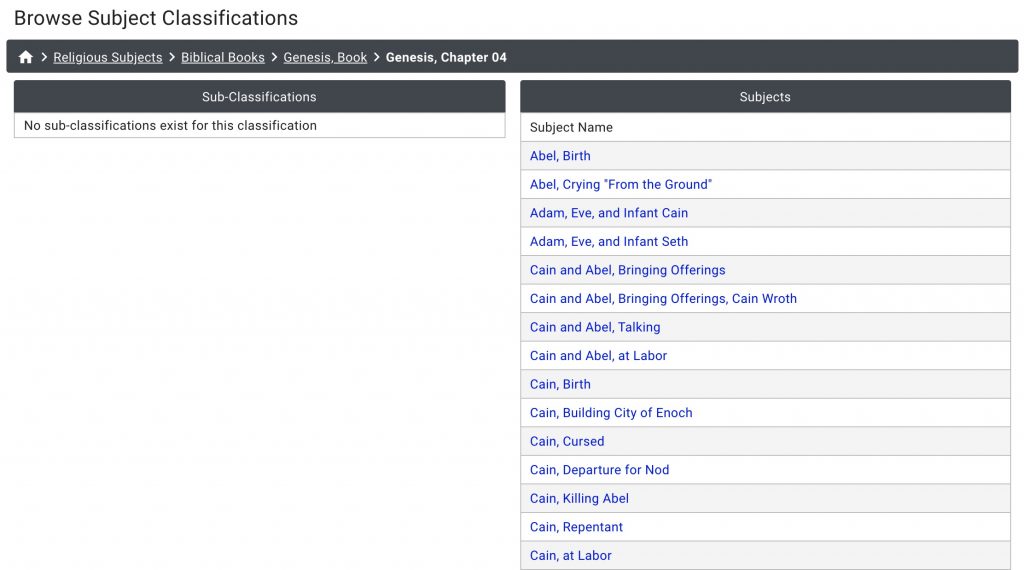
The “Society and Culture” category contains a wide variety of subject terms for representations of medieval daily life. Here you will find types of work, garments, objects, utensils, musical instruments, and furniture that the Index has identified in medieval works of art, plus an array of occupational activities, such as travel, sports, eating and feasting, and hunting scenes. Exploring the category “Sports and Games” might yield unexpected names of pastimes enjoyed in the Middle Ages. Subject terms for games such as “Chess” or “Draughts” are familiar, but others, such as “Whirligig,” might invite a deeper look.


The “Nature” category is a treasure trove for anyone interested in medieval representations of animals, plants, geography, and astronomy. Here you will also find fascinating mythological creatures and hybrid figures alongside visualizations of the seasons, climate, and natural disasters. The “Symbol, Concept, and Ornament” category contains subjects for the more abstract topics in the Index collection. It currently organizes representations of allegories by name and personifications by type, including human characters for the arts, nature, places, time, virtues and vices. This category also includes maps and diagrams, monograms of individual figures, and various kinds of figured, floreate, and foliate ornament.

More a network than a strict hierarchy, the Subject Classification tool is designed to be flexible in its groupings, because the Index of Medieval Art recognizes that medieval iconography does not always fit into predetermined categories or may fit into many categories. For example, Charlemagne, the Carolingian King of the Franks and later Emperor of the Romans was also revered as a saint in some locations, so he appears in multiple parts of the network, including:
When clicking on the lowest-level subject heading, in this case “Charlemagne,” a new page will appear displaying this subject heading’s authority record. The authority record provides an array of useful information, including a Note field at the top offering a definition of the subject, or biographical details, followed by expandable fields containing select bibliographic citations, External References (cross-references to other authorities) and See Froms (alternative names and spellings of the subject). At the bottom of each subject authority is the Associated Works of Art field, an expandable field containing links to all the medieval works of art that feature this iconography.
The authority record’s Subject Classifications field presents the lowest network category, or categories, to which the subject belongs. In the example of “Charlemagne,” it is the name of the individual figure. In other instances, the Subject Classifications for a particular subject might appear on the authority as a broader grouping term. For example, the subject authority for “Drinking Horn” will use the subject classification “Utensils and Objects D–H,” and the subject for “Robin” will use the classification “Birds H–Z.” As noted in the example for biblical books, the subject classifications can also contain names of textual sources, including legends and other narratives.
The evolution of the Subject Classification tool is ongoing, allowing for continuous discovery by both those who use it and those who are building it. As branches of the network spread, new and surprising associations emerge, revealing the richness of the Index’s subject taxonomy. We hope you will enjoy browsing the iconographic headings with this new database tool, which is openly accessible to anyone who visits the browse page of the Index of Medieval Art database.
The Index of Medieval Art Subject Classifications comprises a browsable network that organizes and associates subject terms from our vast taxonomy of medieval iconography. These classifications are descriptive and not prescriptive of medieval works of art cataloged into the Index collection. What follows is an outline of the top three levels of classifications to give Index researchers the broadest overview of subject content.
Heraldry
Heraldic Symbols
Heraldry of Miscellaneous Figures and Families
Identified Heraldry A–Z
Legendary Heraldry A–Z
Historical Figures
Donors A–Z
Founders A–Z
Nobility
Those Who Fight
Those Who Pray
Those Who Rule
Those Who Work
Animals
Birds A–Z
Hunting and Other Scenes
Insects and Invertebrates
Mammals A–Z
Marine Creatures
Reptiles and Amphibians
Astronomy and Astrology
Constellations
Planets and Other Celestial Objects
Sun and Moon
Zodiac
Geography and Geology
Landscape
Minerals and Gems
Mountains
Natural Elements
Rivers
Sea and Ocean
Weather and Natural Disasters
Mythological Creatures and Hybrids
Animal Hybrids
Hybrid Figures
Mythological and Religious Creatures
Plants
Plants and Flowers A–Z
Trees and Their Fruits A–Z
Time
Months
Seasons
Times of the Day
Biblical Books
Genesis, Book–Maccabees, Book
Matthew, Book–Apocalypse, Book
Christianity
Angels and Devils
Christian Legends
Christian Objects and Rituals
Christian Religious Orders and Offices
Death and Afterlife
Divine Manifestations
Images and Attributes of Christ
Life of Christ
Life of the Virgin Mary
New Testament Apocrypha
New Testament Figures
Old Testament Apocrypha
Old Testament Figures
Saints
Types of the Virgin Mary
Greek and Roman Mythology
Mythological Figures A–Z
Mythological Narratives
Islam
Muslim Objects and Rituals
The Life of Muhammad
Judaism
Jewish Biblical Figures and Narratives
Jewish Objects and Rituals
Other Ancient Religions
Egyptian Deities
Gnosticism
Mithraism
Zoroastrianism
Architecture
Cities A–Z
Identified Buildings A–Z
Models of Buildings and Cities
Unidentified Buildings and Structures A–Z
Drollery
Drolleries and Grotesques
Figure Types
Ethnic, National, Religious, and Social Types
Figure Types A–Z
Human Hybrids
Hybrid Figures
Imaginary Figures
Labors of the Month
Months
Furniture
Bed, Bench, Lectern, Throne, etc.
Garments and Accessories
Hats, Headgear, Jewelry, etc.
Human Activities
Eating and Feasting
Hunting and Other Scenes
Medicine and Medical Practices
Occupational A–Z
Social Activities
Sports and Games
Travel and Commerce
Non-Biblical Texts
Literature and Legends
Objects and Rituals
Christian Objects and Rituals
Jewish Objects and Rituals
Muslim Objects and Rituals
Utensils and Objects
Musical Instruments A–Z
Utensils and Objects A–Z
Warfare
Arms and Armor
Military Figures
Military Scenes
Allegories and Personifications
Allegories
Personifications of Arts
Personification of Christological, Symbolic, and Literary Concepts A–Z
Personifications of Nature
Personifications of Places
Personifications of Time
Personifications of Vices
Personifications of Virtues
Maps and Diagrams
Alchemical, Alphabetical, Geometric, Astronomical Diagrams, etc. and Maps
Monogram
Monograms of Individual Figures A–Z and Symbols
Ornament
Animal, Figured, Floreate, and Foliate Ornament

This summer The Index of Medieval Art welcomed two students from the Master of Information program at Rutgers University to inventory the Index’s photographic archive. Comprising nearly two hundred thousand cards in sixteen different medium categories, this historic image collection provides researchers a rich resource of sometimes rare visual references for the study of art produced throughout the Middle Ages. The inventories undertaken by Ryan Gerber and Michele Mesi have illuminated the extent of the archive and helped to assess the image and cataloguing needs for ongoing research and cataloguing at the Index. In this special two-part blog post, we are pleased to present their observations and accounts of their experiences.
It is a testament to the Index’s stimulating power that, despite my lack of an art-historical background, I found myself entranced by the system of cataloguing medieval iconography that the Index pioneered and is still practicing to this day. Its vision of greater accessibility through complete digitization represents another milestone in its long history, and one which will be a gift to scholars of all persuasions and experience levels.
A system largely developed by Index director Helen Woodruff in the 1930s, the photographic archive is organized in the first place by medium, then by location, object type, and the numeric order within that group. Unique codes on the left-hand corner of every index card in the catalogue represent each of these levels of organization. The fruits of this labor are hard to miss after spending any time with the Index and its elegantly interwoven subject index and photographic archive, where one can move seamlessly from subject description to pictorial representations and vice versa.
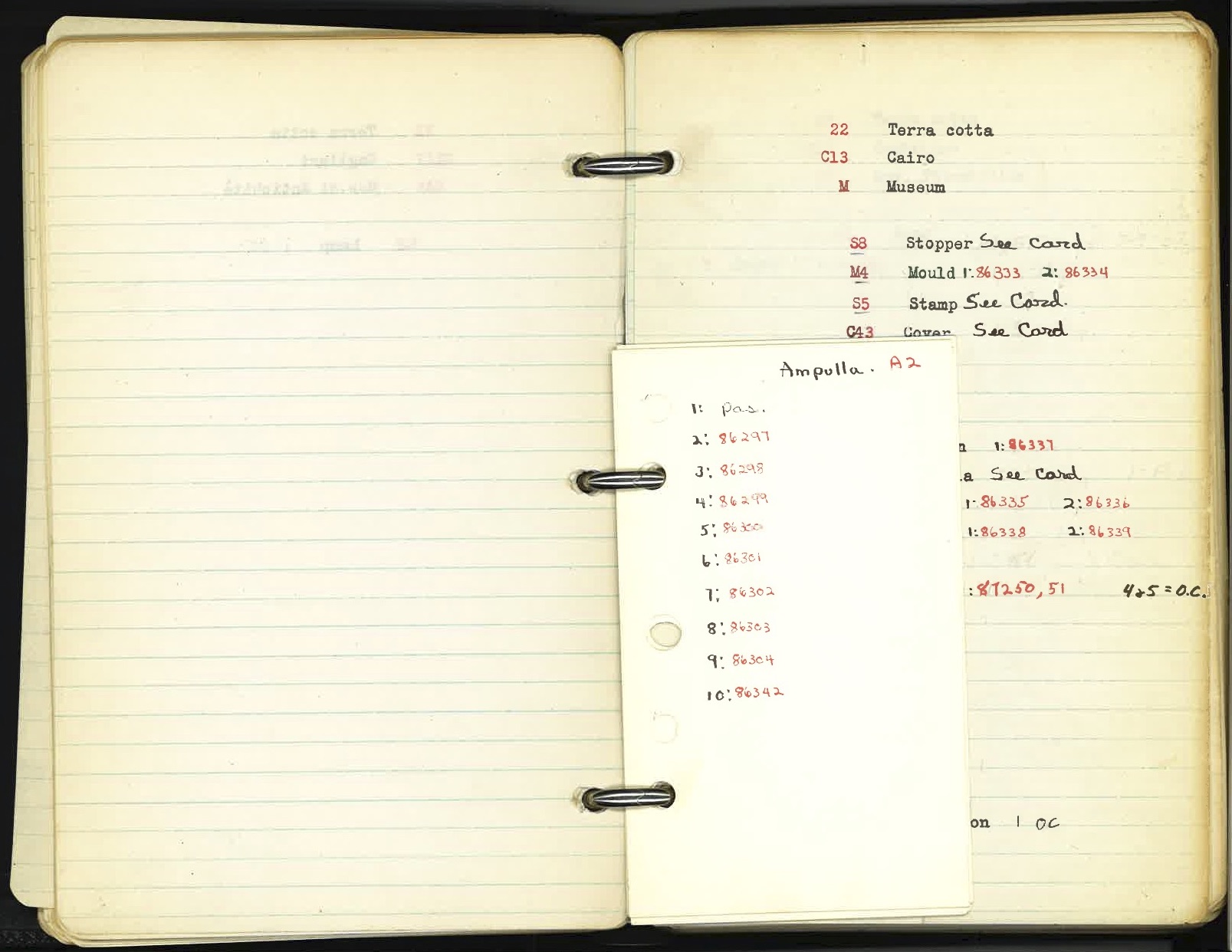
This work has also left behind a trove of archival resources such as hundreds of rolls of film and the so-called “Black Books” that were used to track the negative numbers. Each of the medium categories I inventoried not only laid the groundwork for further analysis of the collection as a whole, but highlighted the Index’s remarkable century-old ability to generate new curiosities and paths of inquiry.
Terracotta, Temporary Cards, Lamps, and Lions
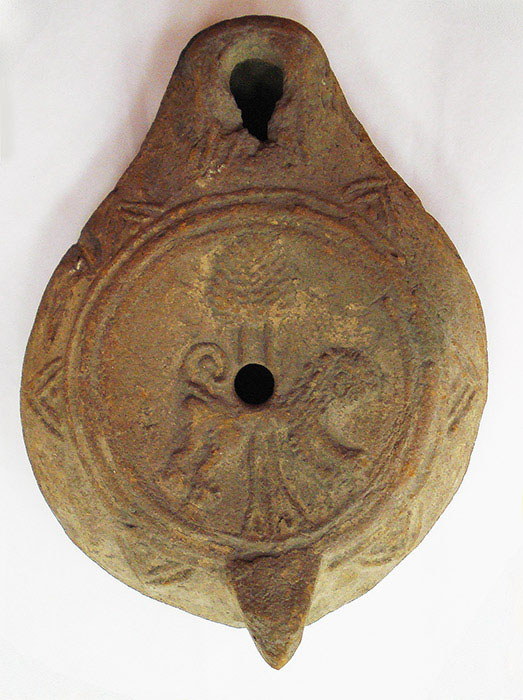
Under the medium “Terra Cotta”—a mixture of clay and water that is formed and baked or fired—the Index records more than twenty-five hundred objects across 196 locations. Of these objects, about sixty-five percent of them are oil lamps. The inventory of these files revealed some of the more common iconographic motifs found on terracotta objects, which include foliate ornament, a variety of land animals and birds, symbols such as crosses, as well as inscriptions and monograms. One terracotta lamp from the Benaki Museum in Athens depicts two of these popular motifs—a lion and a tree—combined on one impressed discus (Fig. 1).
Most photograph cards contain representations of the objects, but they also record the object’s location, the photograph’s negative numbers, subject headings for the image or images on the object, and some bibliographic information. However, there are many temporary “Orange Cards” in the archive that contain only a bibliographic reference and a subject term, and these still await corresponding images. Their inclusion in the original system nonetheless provides important data points about the objects they describe, laying the groundwork for future cataloguers to source the images for these object records. For example, the Index’s photo archive of terracotta objects in the National Museum at Carthage is mostly Orange Cards because the original Index records of these objects derive from a 19th-century publication with very few illustrations. While it would be useful to see images of the “lions” held at the National Museum in Carthage, even in the absence of photographs it may be just as useful to know that, of the 970 terracotta lamps held in that location, nearly four hundred depict animals, and about sixty-five of those include a lion.
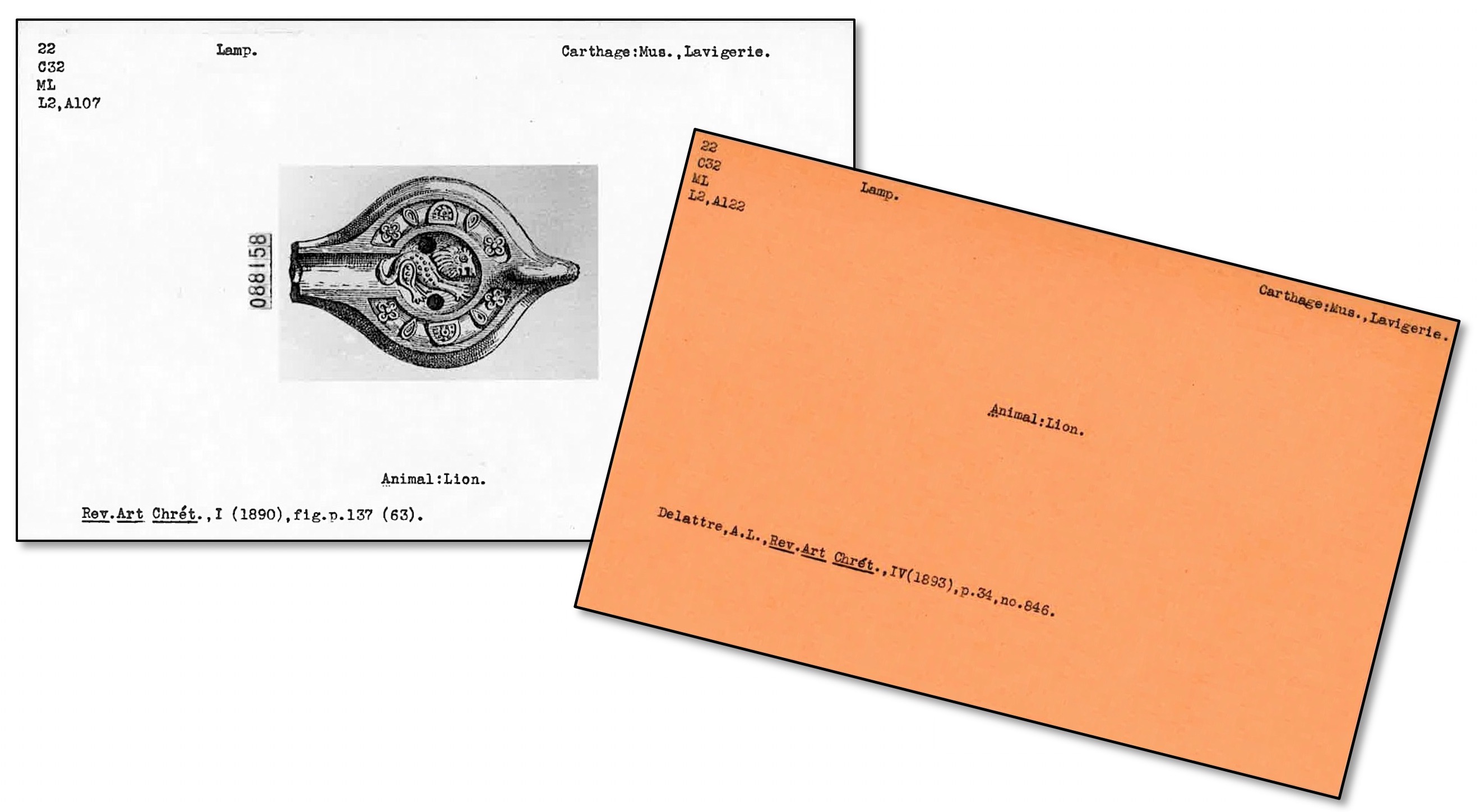
A Face in Gold Glass
The “Gold Glass” files record over 650 objects across sixty-three locations dating mostly from late antiquity between the 3rd and 7th centuries. Of these objects, nearly half are vessels of some kind. Gold glass developed as a medium in the ancient Roman and Hellenistic periods and consisted of decorative engravings made in gold leaf, which were then sandwiched between fused layers of glass. The result was lavish decoration, and exemplary pieces in this medium offer strikingly detailed portraits of their subjects, often depicting married pairs, family groups, or religious figures associated with one another, such as Saints Peter and Paul. Historians have noted the rarity of gold glass, as well as its costly, specialized method of production.[1]
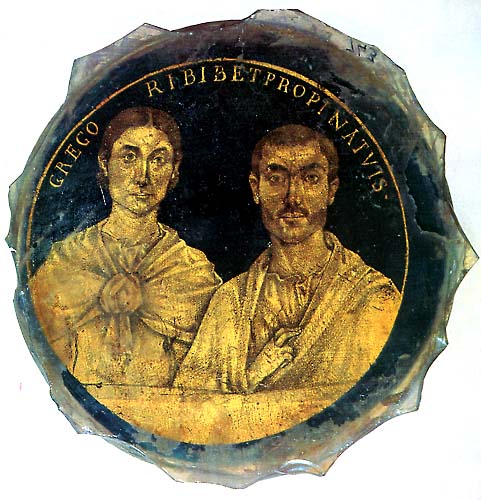
Gold glass was a special interest of Index founder Charles Rufus Morey, and his pioneering catalogue of the Vatican Library’s collections features as its first entry an example also catalogued by the Index. It shows the busts of a married couple inscribed above with the name Gregori and a Latin equivalent of “cheers!”: “Gregori bibe [e]t propina tuis,” or “Gregory, drink and drink to thine!” (Fig. 2).[2]

Another interesting discovery in the “Gold Glass” category was a round vessel fragment last recorded in the Cabinet des Médailles in Paris. It depicts a striking bust of a figure with shorn hair, dressed in a trimmed tunic, and with a distinctive crescent shape on their forehead. The only other information on the photograph card was the source of the image, the antiquities catalogue that Anne-Claude-Philippe de Caylus published in seven volumes from 1756 to 1767.[3] Caylus’s catalogue was a valuable starting point for identifying this figure, whose iconographic description had not been entered in the Index’s subject files or the database. A little more searching led to a color image in a French catalogue, the Histoire de l’art de la Verrerie dans l’Antiquité (Fig. 3), and to the conclusion that the inscription “SAPPO FLACILLAE”—with the genitive form of the empress’s name—referred to a branded enslaved person who had been freed by the Roman Empress Aelia Flacilla (356–386). We also used the photo-editing web application Pixlr to create a positive image of “Sappo” so that the image from the Index archive can now be seen as it appeared in the catalogue of the comte de Caylus (Fig. 4).
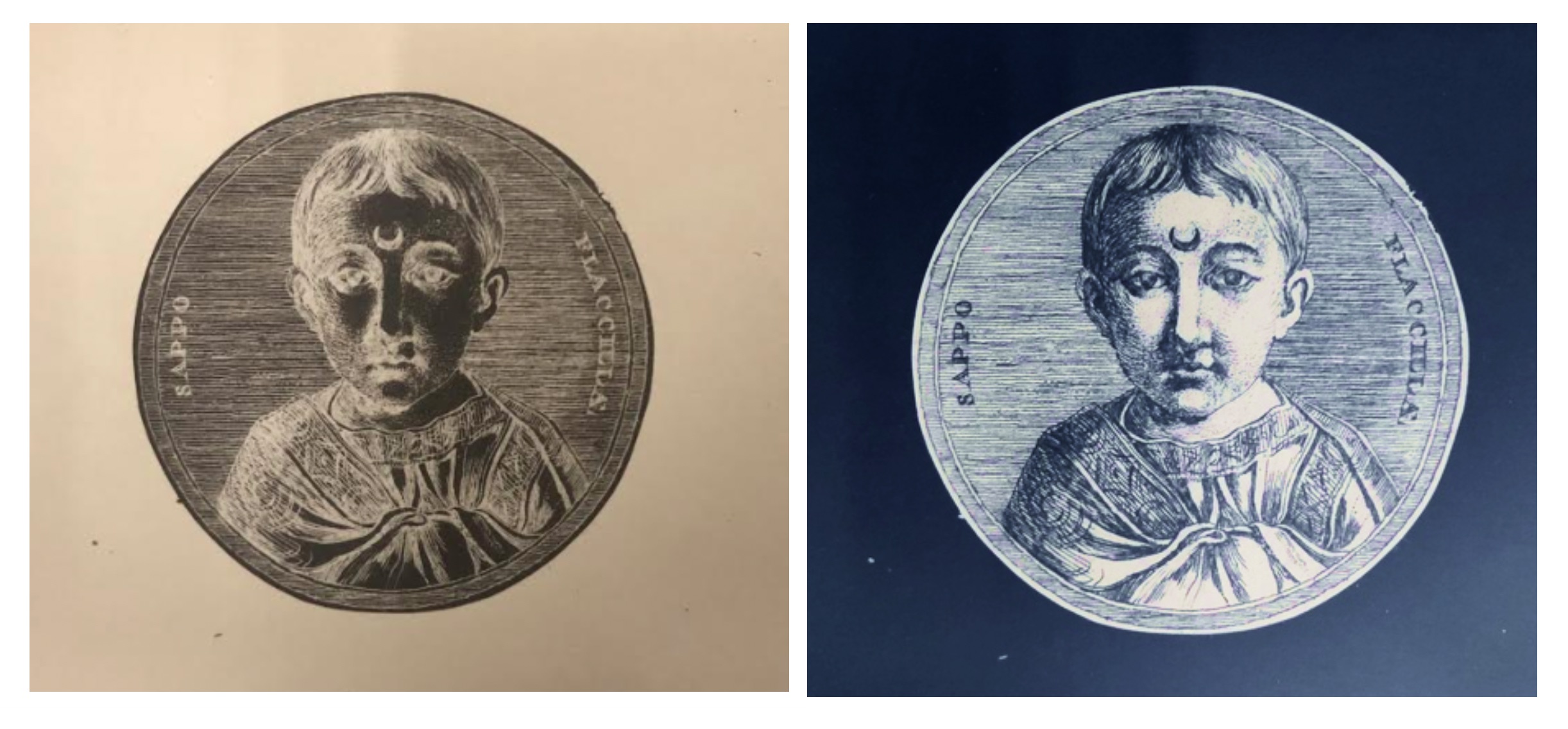
Impressions in Wax
Comprising a little over one thousand objects in 105 locations, the “Wax” medium files are overwhelmingly made up of stamps from Europe dating largely to the 13th and 14th centuries. Although the archive groups these objects into the single object category “Stamp,” the Index database divides them into two Work of Art Types, “Seal Matrix” (that is, the tool used to make the impression) and “Seal Impression” (that is, an impression made by a matrix).[4] Viewing about a thousand examples of Gothic seals intended for both religious and secular officialdom brought into literal relief the development of the production of seal dies from simple figural representations to complex ecclesiastical chapters in miniature, such as the Stamp of Ely Priory, dated to about 1240–1260 (Fig. 5). Other favored subjects in wax seals include heraldry, nobles, and popular saints and bishops, like Thomas Becket. The wealth of iconographic information in the “Wax” files—indeed throughout the archive—emphasizes that the Index is not a closed system, and has at every turn great potential for leading one into new areas of inquiry.

Ryan Gerber is a graduate student at Rutgers University studying Information Science with a concentration in Archives and Preservation. He holds an MA in English from The College of New Jersey with a concentration in Medieval and Early Modern Literature. His interests include digital preservation and retrieval, the digital humanities, and information behavior.
See Part 2 written by Michele Mesi.
[1] Giulia Cesarin, “Gold-Glasses: From their Origin to Late Antiquity in the Mediterranean,” in Things that Travelled: Mediterranean Glass in the First Millennium AD (London: UCL Press, 2018), 22–45.
[2] Morey noted of the inscription that “the E of ‘bibe’ or of ‘et’ [was] omitted by mistake.” Charles Rufus Morey, The Gold-Glass Collection of the Vatican Library (Vatican City: Biblioteca Apostolica Vaticana, 1959), 1. Translation after Georg Daltrop in Leonard von Matt, Georg Daltrop, and Adriano Prandi, Art Treasures of the Vatican Library (New York: Abrams, [1970]), 168.
[3] Anne-Claude-Philippe de Caylus, Recueil d’antiquités égyptiennes, étrusques, greques, romaines et gauloises (Paris, 1756–57), 193–205, pl. 53.2, https://archive.org/details/recueildantiquit03cayl/page/n10.
[4] See the Index database Work of Art Type browse list to access these Work of Art References.

Precious Gems Containing a Wealth of Iconography

“Glyptic” is among the smaller medium categories in the Index archive, filling only one drawer with a little more than eleven hundred cards that record only about nine hundred objects. The term “glyptics” refers the art of carving gems or seals—whether in intaglio or in relief—typically in gems or precious stones such as jasper, agate, carnelian, and amethyst.[1] This form of art is one of the oldest—known since the Mesopotamian, Egyptian, and Assyrian civilizations—but it was not until the Hellenistic period that relief cameos, seals, and more intricate glyptic objects began to appear.[2]
Glyptics, which were often worn as jewelry or incorporated into ecclesiastical objects, are recorded in the Index primarily as gems, amulets, plaques, rings, and stamps, and the largest category, cameos, which makes up nearly a third of the glyptic objects in the Index files. A significant portion of the subjects on these carved gems include animals and plant life, like doves, dolphins, fish, palm trees, and fantastic creatures. There are other symbols as well, such as the anchor, which appears on over forty examples. A significant number of glyptics incorporate classical and mythological figures, such as Orpheus, Diana, Jupiter, and Hecate. Nearly twenty cards for gem objects record the Gnostic figure Abrasax (Fig. 1). Glyptics such as these were powerful talismans for their owners.
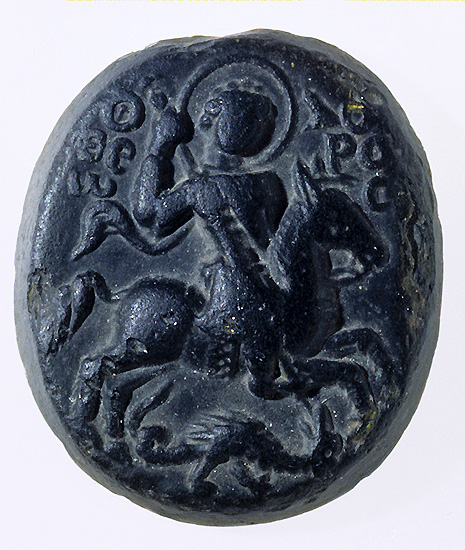
The traditional use of spiritual amulets was also adopted by Christians using Christian symbols and themes.[3] Christian iconography on glyptics include the triumphant Archangel Michael or Saint George, Daniel in the Lion’s Den, and the Good Shepherd. One cameo of opaque black glass made in the 13th century depicts Saint Theodore transfixing the dragon and well represents the preference for saintly imagery on later cameos (Fig. 2).[4] The inventory also revealed that there were nearly thirty examples of incised depictions of monograms on glyptics with a third of them being the Chi-Rho, a symbol for Christ consisting of the first two letters of the word “Christos” (Christ) in Greek.
The major collections represented in this medium include the Staatliche Museen in Berlin (over eighty objects) and the British Museum in London (nearly 125 objects. However, a large number of glyptics (over 140 objects) are recorded as “Location Unknown,” these items having been entered into the Index from major publications that did not provide the precise location at the time of publication.
Radiant Ivories for Both Secular and Religious Narratives

With nearly forty-seven hundred cards covering a little over thirty-one hundred objects, Ivory represented a more extensive category in this inventory project. The types of ivory objects recorded by the Index range from plaques, chess pieces, croziers, and triptychs to the more unusual oliphant (or hunter’s horn) to the handles of various utensils, and even a saddle. Some of the major collections represented in this medium are the Musée du Louvre and the Musée de Cluny in Paris, and the British Museum and the Victoria and Albert Museum in London. Ivory objects were expertly carved in minute detail, usually from the tusks of elephants. In the Index database, ivory acts as a “parent medium,” an umbrella covering such materials as bone, walrus tusks, and antlers.[5]
Various motifs of courtly love were often depicted on ivory caskets, plaques, mirror cases, combs, and other fine domestic objects.[6] A preference for secular subjects on ivories emerged in the twelfth century when an influx of secular imagery was brought to Europe from the Middle East after the Crusades, as well as through a rise in vernacular literature, legends, and romances.[7] Entertaining stories such as the tale of the Virgin and the Unicorn provided plenty of thematic material to adorn precious ivory objects. They often offered a double meaning or moral lesson, as in the story of Tristan and Isolde depicted on an early 14th-century ivory casket now in the Metropolitan Museum of Art, which warns against temptations of lust (Fig. 3).[8]
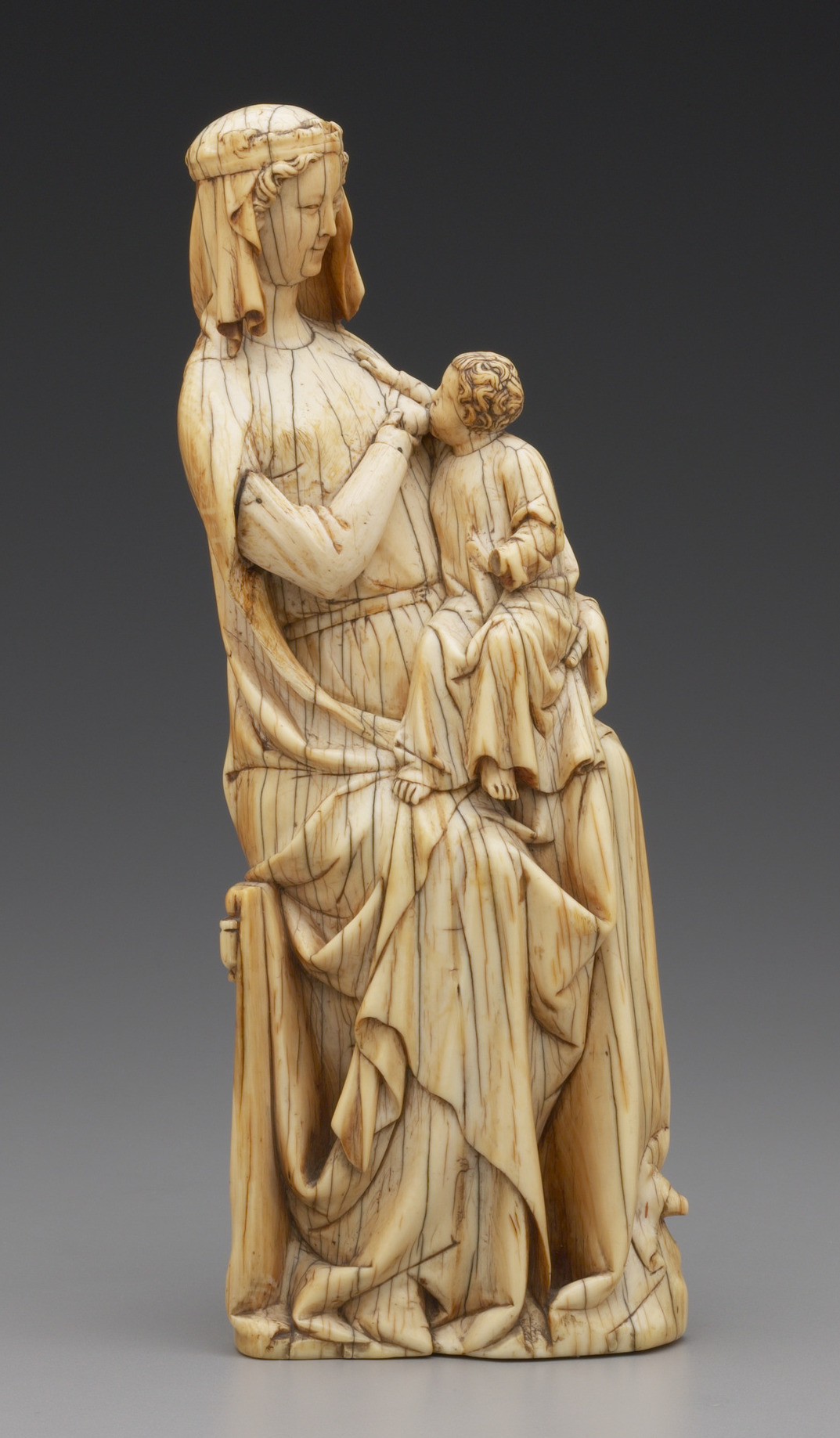
Despite their popularity, secular ivories are fewer in number than devotional works of art in ivory. Roughly a quarter of the ivory objects recorded in the Index are representations of the Virgin Mary and the Christ Child. This figure rises to more three quarters when we add individual figures of Christ or the Virgin Mary. One type seen rather frequently is that of the Virgin nursing the infant Christ—known in Latin as the Virgo Lactans—which the Index categorizes among the many “types” of the Virgin Mary and Christ Child. In the database, the subject heading Virgin Mary and Christ Child, Suckling Type is attached to over 290 Work of Art records. More than forty of these are ivory. This Virgo Lactans iconographic type is exemplified by a 14th-century ivory statuette in the Yale University Art Gallery, which displays an intimate and lifelike relationship between mother and child (Fig. 4). Thus, the devotional message is made personal.
The Project Continues …
Encompassing eight drawers of roughly one thousand cards each, “Painting” proved to be an abundant medium, but “Illuminated Manuscript” is by far the largest medium category in the Index, filling fifty-six of the photograph drawers. Medieval art objects encountered in these two categories range from painted icons and altarpieces to a wide variety of liturgical manuscripts and other illuminated books numbering perhaps in the thousands. The inventory of these and other remaining categories—including those comprising in situ works of monumental art, such as “Mosaic” and “Fresco”—will continue after this summer.
As a “living archive” that covers more than a millennium of artistic creation, the Index of Medieval Art has always been improved and expanded by the interactions of the cataloguers who create it with the with researchers who use it. Creating these inventories has been an illuminating way to participate in that process and to learn more about the contents of the Index card catalogue being prepared for entry into the online database. This project was challenging at times, due to the sheer breadth of the paper files, but it has been an invaluable undertaking for the ongoing process of research and digitization, and will improve accessibility to the records contained in this century-old archive of medieval art.
Michele Mesi is a graduate student at Rutgers University studying Information Science with a concentration in Archives and Preservation. From Rutgers University, she also holds a Bachelor’s degree in English with studies in Art History and in Digital Communication, Information, and Media. Her interests include art conservation, archival processing, and working with rare books and manuscripts.
See Part 1 written by Ryan Gerber.
[1] The Index of Medieval Art follows the standards for material description established by the Getty Art & Architecture Thesaurus (AAT). See the Art & Architecture Thesaurus® Online, https://www.getty.edu/research/tools/vocabularies/aat/.
[2] O. Neverov and A. Durandin, Antique Intaglios in the Hermitage Collection (Leningrad: Aurora Art Publishers, 1976), 7.
[3] Neverov and Durandin, Antique Intaglios, 8.
[4] The Index records the iconography in question as Theodore Tyro or Theodore the General, Slaying Dragon.
[5] See the glossary entry on the Index database Medium browse list for “ivory.”
[6] J. Lowden and J. Cherry, Medieval Ivories and Works of Art: The Thomson Collection at the Art Gallery of Ontario (Art Gallery of Ontario, 2008), 122.
[7] R. H. Randall, “Popular Romances Carved in Ivory,” in Images in Ivory: Precious Objects of the Gothic Age (Detroit Institute of the Arts, 1997), 63.
[8] Randall, “Popular Romances,” 67–68.
54th International Congress on Medieval Studies, Kalamazoo, MI, May 9 to 12, 2019
Sponsored by the Index of Medieval Art, Princeton University

Organizers: M. Alessia Rossi and Jessica Savage (Index of Medieval Art, Princeton University)
Stemming from the launch of the new database and enhancements of search technology and social media at the Index of Medieval Art, this roundtable addresses the many ways we encounter medieval iconography in the twenty-first century. We invite proposals from emerging scholars and a variety of professionals who are teaching with, blogging about, and cataloguing medieval iconography. This discussion will touch on the different ways we consume and create information with our research, shed light on original approaches, and discover common goals.
Participants in this roundtable will give short introductions (5-7 minutes) on issues relevant to their area of specialization and participate in a discussion on how they use online resources, such as image databases, to incorporate the study of medieval iconography into their teaching, research, and public outreach. Possible questions include: What makes an online collection “teaching-friendly” and accessible for student discovery? How does social media, including Twitter, Facebook, and blogging, make medieval image collections more visible? How do these platforms broaden interest in iconography and connect users to works of art? What are the aims and impact of organizations such as, the Index, the Getty, the INHA, the Warburg, and ICONCLASS, who are working with large stores of medieval art and architecture information? How can we envisage a wider network and discussion of professional practice within this specialized area?
Please send a 250-word abstract outlining your contribution to this roundtable and a completed Participant Information Form (available via the Congress Submissions website: https://wmich.edu/medievalcongress/submissions) by September 15 to M. Alessia Rossi (marossi@princeton.edu) and Jessica Savage (jlsavage@princeton.edu). More information about the Congress can be found here: https://wmich.edu/medievalcongress.
Third in a series of short blog posts introducing new features of our online database
Have you tried out our Medium filter yet? As part of our ongoing series introducing specific features of our database to assist you in developing research strategies, let us direct your attention to the Medium field. First, you may ask, what exactly do we mean by “Medium”? In the Index database, “Medium” refers both to the materials that compose the work of art and to the methods of facture or technique employed in its creation. As Herbert Kessler rightly observes, “matter mattered in the Middle Ages,” and we at the Index wish to foster exciting new scholarship related to the iconography of materials.[1] A cursory glance at our Medium category under the “Browse” tab reveals an extraordinary array of materials and techniques. Objects may include materials ranging from “acacia” wood to “zeiler sandstone,” and all these materials might have been “hammered” and “punched,” or “chiseled” and “incised,” or subjected to many other possible means of manipulation.
But what if you are not ready for this level of specificity? For more general Medium searches, we have devised a series of basic category terms to help you find what you need: “stone,” “gems,” “wood,” “ivory,” “metal,” “enamel,” and “textile.” For example, let’s say you’re interested in representations of the Virgin Mary in any kind of stone. A keyword search for “Virgin Mary” on the database homepage will yield thousands of results in all media. So, if you want to limit your results to images in stone, simply find the “Filters” tab under “Advanced Search” and select “stone” under the Medium filter. Click on “Search,” and you will reduce your list to 1,752 records.
Now what if you know that you’re searching for representations of the Virgin Mary in a specific kind of stone? This time, let’s say you’re looking for marble sculpture. Instead of sifting through all 1,752 records for marble examples, just try selecting “marble” in the Medium filter. This should bring your results down to a mere 410 records.
You can also try refining your search with another filter. Interested in marble representations of the Virgin produced in medieval France? Add “France” in the Location filter, and you’ll narrow your results to 55 records.
So, whether you’re searching within broad categories or examining specific materials and techniques, try using the database’s Medium filter to adjust your search to your research interests.
Here are a few additional pointers:
So, as you undertake your research with us, we hope that you’ll give the Medium filter a try. As always, please feel free to send us questions or comments about any aspect of the IMA database. Contact us at theindex@princeton.edu. Matter matters…and so does your feedback!
[1] Herbert Kessler, Seeing Medieval Art (Peterborough, Ont.: Broadview Press, 2004), 14.
Second in a series of short blog posts introducing new features of our online database
Have you tried our Language Filter yet? Since we at the Index of Medieval Art realize that some of the search features available to users of the new database may be unfamiliar, we thought that we ought to take some time to recommend and explain a few of them. This time, let’s discuss your use of language, shall we? Specifically, did you know that you can filter your searches to look for images that appear in the context of a certain language? Well, you can!
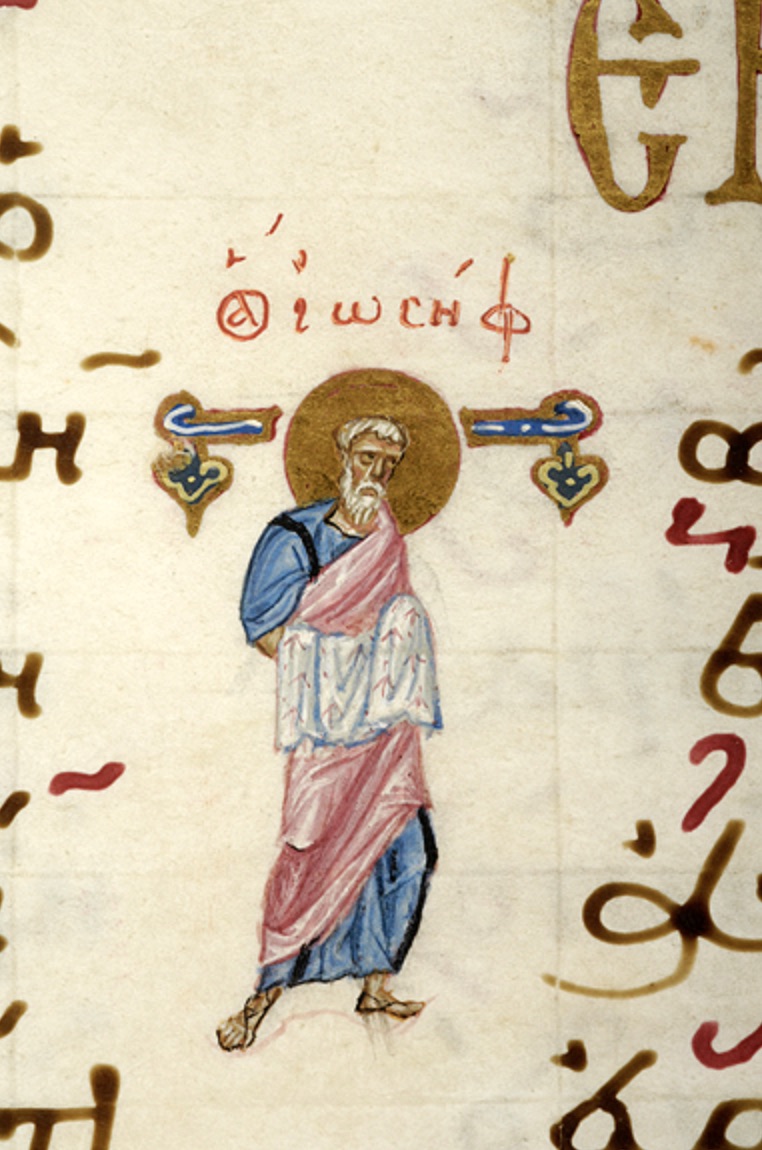
Say you’re interested in images of Joseph of Arimathea, for example, whether in a scene—such as the Deposition or the Entombment—or as an isolated figure. You might start with a simple keyword search for “Arimathea” on the database homepage, or you could also use the “Terms” tab on the “Advanced Search” page, checking “Description” and “Subject” in the “Search Fields” checklist, a strategy that currently yields a whopping 735 results.
Now let’s try using one of the filters. Simply switch to the “Filters” tab on the “Advanced Search” page. Feel free to explore, and try all or any of the filters. For the purposes of this demonstration, however, we’re thinking about language, so let’s start by narrowing our search to manuscripts. Simply select “Manuscript” in the Work of Art Type Filter (Example 1), then click “Search” again. You’ll discover that, in this case, you have nearly halved the search results to 373, but that’s still a lot of records to consider.

Now here comes the exciting part! If you know that you’re interested in a particular linguistic context, then you can add the Language Filter to your Advanced Search. There are currently 48 languages to choose from in the Index of Medieval Art database. For this demonstration, we’ve specified Greek (Example 2), so we’re searching for the word “Arimathea” where it appears in either the Subject field or the Description field, only in records for which the Work of Art Type is “Manuscript” and the language of the manuscript is “Greek.” Click “Search,” and you’ll discover that you have been able to filter your results down to a manageable 32 records!
Simple, n’est-ce pas?
You can easily change the Language filter to compare results from one language to another. Changing Greek to Armenian yields ten results. Church Slavonic yields six. Filtering for some languages may return nothing, others quite a lot. Latin, for example, returns 233 results, so you might want to add another filter to your search. For the time being, only the languages of manuscripts are identified in the database. Eventually, however, the Index database will identify the language or languages of every object that incorporates the written word.
You might have noticed that names of some languages include date ranges, as in “Middle English (1100–1500).” Although such dates can seem arbitrary, we try to differentiate among the stages of a language’s development. If you’re curious about how the Index defines a language, or about what sources we cite, you can click on the language name in the Language field of a Work of Art record. This will take you to a page where you can read the Language Details. There you’ll also find citations and external reference codes (Glottolog and ISO 639-3). On that page, there is also a list of all Work of Art References that include that language.
So, start exploring, and be sure to try out the filters available in the new Index of Medieval Art database. Also, please let us know what you think…but mind your language!